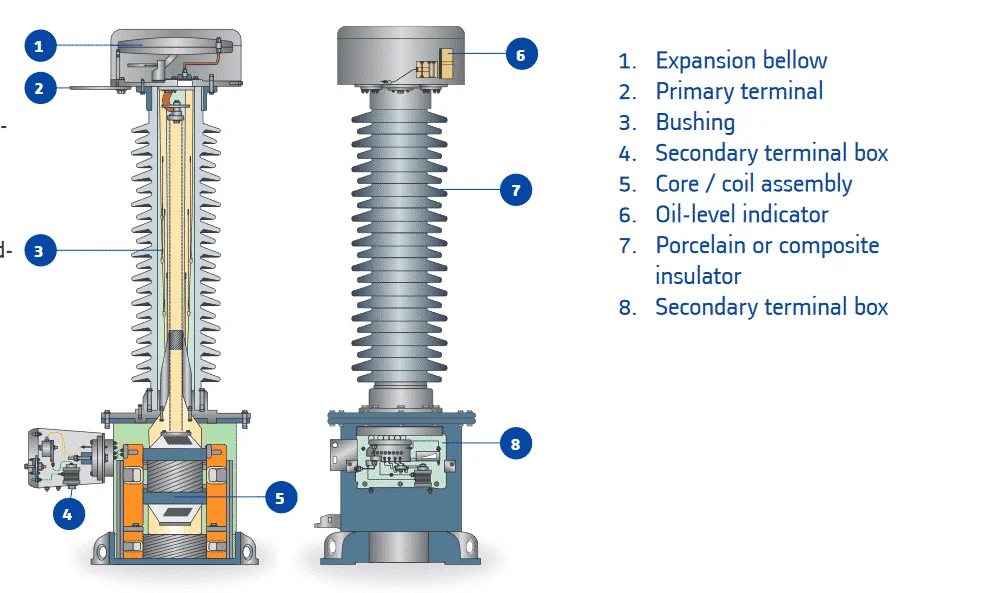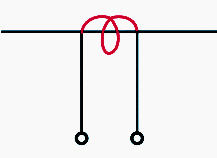What is an instrument transformer?
Instrument transformers are current and voltage transformation devices that are used to step down the transmission and distribution line voltages and currents to levels that can safely operate measuring instruments, protection devices and control relays by isolating it from the supply voltages.

The above diagram shows the basic usage of instrument transformers. They are used to transform the primary voltage or current to values that are suitable for measuring instruments such as voltmeters, ammeters, watt-meters, energy-meters, power factor meters, frequency meters etc, and protection relays and control equipment. In addition to that, they can act as an isolation between the instruments and high voltage circuits.
In addition to the basic merits mentioned above, it has a commercial advantage also. Power generation, transmission and distribution networks have different voltage level. Designing instruments that can safely operate at all these voltage levels and maintaining a huge inventory is highly impractical. Manufacturers design instruments suitable for 120V or 5A, which in combination with suitable instrument transformers can be connected to high voltage and high current circuits.
Types of Instrument transformers
There are two types of Instrument transformers:
- Current transformers (CT)
- Voltage transformers or potential transformers (VT or PT)
Current transformers
Transformers that are used to transform currents are known as current transformers. They are used to reduce high currents to 1A or 5A so that they can be measured using an ammeter or used in other control circuits. It consists of a single or fewer primary turns and large numbers of secondary turns. In most types, the current-carrying conductor itself acts as the primary winding of the transformer.
The primary of the current transformers is connected in series to the line while the secondary is connected to the measurement, control or protection devices. Current transformers serve two purposes: 1) facilitates the measurement of high currents and 2) Insulation of meters, instruments and protection relays from high voltages.
Based on the type of construction, current transformers are classified into three types as follows:
- Window CT or toroidal CT: hollow core through which the current-carrying conductor or cable is passed.
- Bar CT: contain a copper or aluminium busbar surrounded by the secondary winding wound over the ferromagnetic core.
- Wound CT: They have separate primary and secondary winding.
Read more: Current transformer – working, types and connection
The secondary circuit of connected of the current transformer must never be opened while the transformer is excited by primary current, because due to higher turns ratio, high voltages are induced at the secondary which may be hazardous to insulation and to personnel and because the accuracy of the transformer may be adversely affected.
Voltage transformer or Potential transformers
Instrument transformers that are used to transform voltages are known as voltage or potential transformers. They are used to reduce high voltages to 120V or other lower levels so that they can be measured using a voltmeter or used in other control circuits. It consists of a magnetic core upon which a large number of primary turns and fewer numbers of secondary turns are wound. They are designed for optimal performance with high impedance secondary loads.

The primary winding of a voltage transformer is connected in parallel with the load for which the voltage is to be measured or controlled. The secondary winding is connected to measuring instruments and control devices. There are three types of potential transformer:
Electromagnetic induction type: Principle similar to two winding transformer.
Capacitive-coupled type: A capacitive-coupled voltage transformer is a combination of capacitance voltage divider and electromagnetic type PT.
Optical type: An optical voltage transformer works on the principle of Kerr effect, by which the light which is reflected from a magnetized surface may change both polarization and reflected intensity.
Comparison of current transformer and potential transformer
Burden and accuracy in instrument transformers
Rated burden: The amount of load that can be imposed on the secondary of the instrument transformers without causing an error higher than that defined by its accuracy class.
Accuracy class: Accuracy class describes how accurate the transformation of the instrument transformers would be when the burden within the allowable limits.
Polarity: Polarity makings are done on a transformer to show the relative instantaneous directions of current flow in primary and secondary terminals. This indicates the direction of secondary current when primary current is flowing into the marked primary terminal.
Advantages of instrument transformers
- They isolate measuring instruments and control circuits from high voltage circuits.
- Manufacturers design instruments suitable for 100 to 120V or 1A & 5A, which in combination with suitable instrument transformers can be connected to high voltage and high current circuits.
- Instrument transformers ensure the safe operation of instruments and operating personnel.
- Several instruments can be connected to a single instrument transformer provided the combined burden will not exceed the rated burden of the transformer.
Read more: Difference between current transformers and Potential transformers



more information